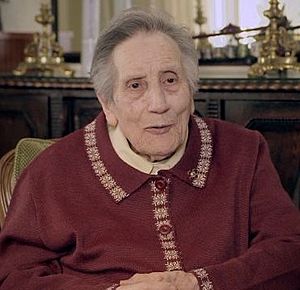Gertrudis de la Fuente facts for kids
Quick facts for kids
Gertrudis de la Fuente
|
|
|---|---|
 |
|
| Born |
Gertrudis de la Fuente Sánchez
21 August 1921 |
| Died | 23 January 2017 (aged 95) Madrid, Spain
|
| Alma mater | Complutense University of Madrid |
| Scientific career | |
| Institutions | Consejo Superior de Investigaciones Científicas |
Gertrudis de la Fuente Sánchez (born August 21, 1921 – died January 23, 2017) was an important Spanish scientist. She was a biochemist who studied enzymes. Enzymes are special proteins that help chemical reactions happen in living things. Gertrudis de la Fuente was a professor at the Spanish National Research Council in Madrid.
She also helped the Spanish government with a big health problem in 1981. This problem was called the toxic oil syndrome. A short film about her life and work, called Gertrudis (la mujer que no enterró sus talentos), was released in 2016.
Contents
Early Life and Education
Gertrudis de la Fuente Sánchez was born in Madrid, Spain, on August 21, 1921. Her father worked as a train driver. When she was six, her family moved to Arroyo de Malpartida, Cáceres.
She grew up in a countryside area. In those days, girls there usually did not go to school past primary grades. Gertrudis did not start high school until her father retired. In 1935, she moved to Madrid. She began studying for her baccalaureate, which is like a high school diploma. However, her studies were stopped by the Spanish Civil War.
She continued her education and graduated in 1942. In 1948, she earned a bachelor's degree in chemistry from the Complutense University of Madrid. She also took physics classes while at university. Gertrudis started her research career by working for free. She worked in the pharmacy department with Santos Ruiz, who was the only biochemistry professor in Spain at that time. In 1950, she received a grant to work on her PhD. She finished her doctoral thesis in 1954.
Her Scientific Career
In 1956, Gertrudis de la Fuente became a collaborator at the Spanish National Research Council. She was promoted to researcher in 1960. Then, in 1962, she became a full professor.
In 1970, the Institute of Enzymology moved. It went to the Faculty of Medicine at the Universidad Autónoma de Madrid. In 1981, the Spanish government asked her to lead an investigation. This investigation was about a serious health crisis called the toxic oil syndrome.
Investigating the Toxic Oil Syndrome
In 1981, Spain faced a terrible event called the toxic oil syndrome. Many people became sick because of poisoned industrial rapeseed oil. This oil had accidentally ended up being sold for people to eat.
The illness lasted for about 40 days. It affected more than 20,000 people. Sadly, over 1,100 people died. Gertrudis de la Fuente was part of a special group. This group was called the Advisory Commission for Scientific and Technical Research. Her work helped to understand and deal with this major health crisis.
Later Life and Legacy
Gertrudis de la Fuente continued to teach and guide students working on their PhDs. She did this until she retired. In 2015, a film was made about her life, her education, and her scientific work.
She received the Club of 25 Award for her important contributions to science. Gertrudis de la Fuente passed away in 2017. People remembered her as being "active and serene." She was also known for being "steadfast in equality – for women and in general." This was said by María Jesús Santesmases, who remembered her fondly.
See also
 In Spanish: Gertrudis de la Fuente para niños
In Spanish: Gertrudis de la Fuente para niños
- List of Spanish inventors and discoverers

